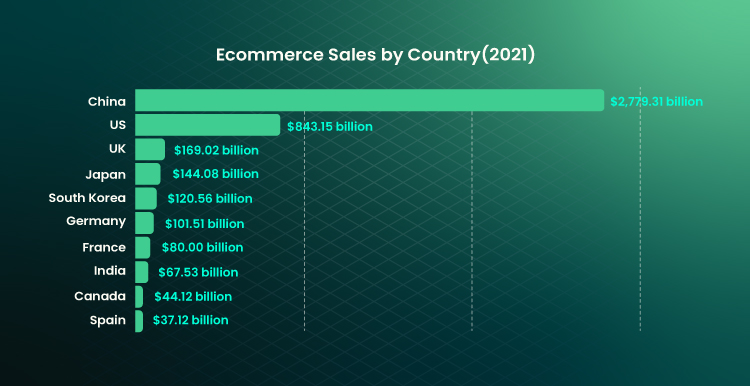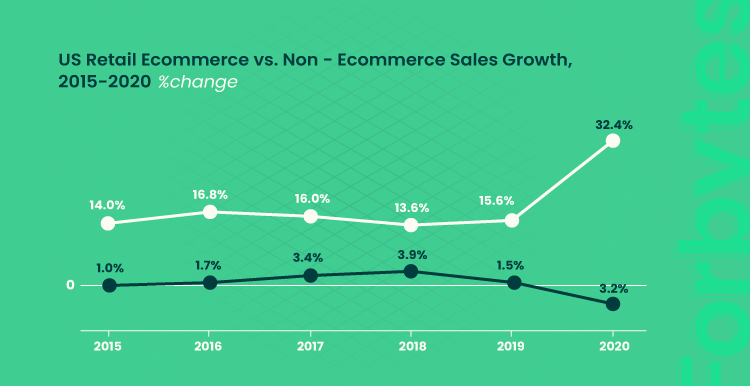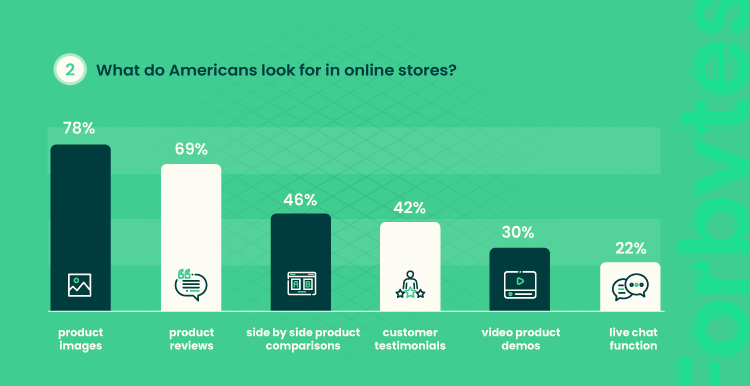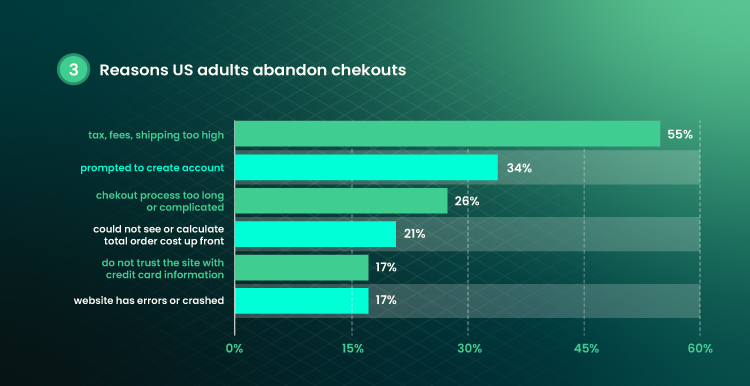Once your hard work pays off and you turn your idea into a viable business opportunity, you move on to the next big step – running your business successfully. Unfortunately, not all companies can enjoy constant growth and development. Do you want to prevent your business performance, conversion rates, and profits from diminishing? If so, you’ll need to identify possible fallacies and start fixing them.
This article presents the Top 5 business challenges of e-commerce companies that they face frequently. If you experience them too, mind the suggested wayouts or contact our team to get help. Forbytes is at your disposal anytime and can build solutions to automate and streamline your business tasks and give you better ROI.
eCommerce Market Overview
If you wonder about e-commerce growth, here’s a quick overview:
Let’s dive into the details. So, the eCommerce sector is selling and buying goods, services, and products with the help of digital channels. eCommerce is tightly linked to other digitized industries such as online banking, the client support segment, and more. The biggest part of ecommerce businesses run in the B2B sector but there also are many opportunities for B2C vendors.
eCommerce is rapidly growing. Last year, the e-commerce market share value was more than $13 trillion. By 2027, it’s going to grow 4 times. In 2021-2027, the e-commerce CAGR will be more than 27%. The big figures point to the growing popularity of online shopping and the rising consumer expectations for digital activities.

Most revenue from e-commerce is generated in China. The rise of urbanization is one of the key factors determining the growth of this segment. The spread of 4G and 5G technologies and the accessibility of the Internet also form the ground for the increase in online sales.
eCommerce gives vendors the means for running a business without the need for a physical presence anywhere. Going digital helps companies cut operation costs and streamline communication with clients and partners. On top of that, we witness the boom of social media platforms and the growing role of social media in consumer life. This makes it easier for e-commerce businesses to reach directly the right audience using multiple sales funnels.

Challenges of eCommerce. Top 5 List
Business Challenge #1: Fighting Competition
This is the first among the challenges of small businesses operating in e-commerce. eCommerce is a very competitive environment. Last year, global e-commerce sales reached almost $5 trillion. Online retailers compete with other online business owners as well as offline vendors. You need to put in extra effort to stand out, and there are plenty of ways to do so. For example, you can offer excellent client service by adding an AI-powered chatbot or the opportunity to talk with a consultant anytime via live chat. Another way to differentiate is to prove yourself to be an expert in the focus field. Share your tips, recommendations, and pieces of advice with your users to earn their recognition. In short, give your clients the service they won’t get from your competitors.
Solution
Provide your client with extra value that your competitors are unable to give. Your customer will have the choice: to choose your competitor and get a product or to choose you and get a product plus additional value. What are they likely to choose for their own benefit? Here it is. There are many different ways how to give this extra value. You can share useful educational content related to the products you sell. Or you can offer bundled products on sale or a loyalty program where clients can earn points and use them in their next purchases. Another option: you integrate cutting-edge technologies into the customer journey to ensure an unforgettable user experience. For example, AR technology may be used to give users a chance to try products on and make informed purchase decisions. Also, it may be a fun experience in a virtual store that will attract more customers to your main store.

Business Challenge #2: Supply Chain Issues
It may seem like a small business challenge. But reality shows the opposite. On average, the accuracy of supply chain management is around 60%. A lack of accuracy leads to calculation errors, mistakes, delivery delays, and low customer satisfaction rates. The reason for poor supply chain management may lie in the lack of a consistent strategy that would unite the work of all departments under one roof. If you want to achieve better supply chain metrics and increase the number of paying customers, you need to renovate your back-office operations.
Solution
Effective commerce is impossible nowadays without powerful software solutions. Supply chain management tools can help you automate tasks, streamline time-consuming processes, and decrease the volume of manual work. By digitizing your supply chain, you will ensure real-time access to essential data on your stock, product journey, and interaction with stakeholders. Investing in supply chain and order management digitization will be a win-win decision for your business. Firstly, you will reduce the volume of manual work of your employees as many of their tasks will be automated. Secondly, you will ensure an uninterrupted product journey, which will cut supply chain costs and speed up delivery. Thirdly, supply chain solutions will make your cooperation with partners and suppliers more convenient. You can integrate your system with other solutions they use via API or other types of protocols and ensure data connectivity across all channels.
Business Challenge #3: Financial Planning
When you run a small business, this may seem not like a problem. But as soon as you start making a profit and grow, you’ll have to choose where to invest and how much to invest. How to know what part of your profit should be invested back into your business? And how much money can you take as your profit? Also, how to know where should you invest your money? Such questions can be answered intuitively. You can learn a lesson from your own mistakes and take risks. But it’s better to base them on insightful data generated by AI-powered tools and solutions.
Solution
If you are an online retailer with a rapidly growing e-commerce store, you need an effective Business Intelligence strategy for your business. By 2025, the global Business Intelligence market is expected to grow to $33.3 billion. The reports say that nearly half of the small companies implement BI tools and features in their business strategies. BI solutions enable real-time data integration into dashboards as well as ad-hoc analytics. E-commerce AI is also used to visualize data. AI enables predictive analytics that is used to make informed decisions on investments. When you use such a tool, you get a better understanding of where to invest to cut risks and get the best return.
Business Challenge #4: Generating Leads
This is one of the crucial challenges of a small business. Big figures are not the ultimate indicator of big sales. You may have enough website visitors but fail to convert them into leads. This can point to the problems that users face on your website. It can be that their experience on your e-commerce store is not shoppable enough. Or they lack guidance and motivation to proceed with the purchase. Or, users experience some technical issues when exploring your services. If your page loads too slowly, it can result in 97% mobile shopping cart abandonment. How slow is too slow? Google estimates that visitors will give your e-commerce website 3 seconds to load before moving on to “greener pastures”. All these business problems require you to conduct an audit of the user journey and make it more engaging by leveraging technology.
Solution
Put yourself in the client’s shoes. Reproduce their journey starting from the moment they see your website in the search results and to the moment they place an order. Ask other team members to help you with this task to detect issues faster. Also, you can use tools that help make e-commerce sites better. PageSpeed Insights analyzes your website’s mobile and desktop versions. It provides you with a grade out of 100 and feedback on how to improve your solution. If you have an issue on the desktop, that same issue will likely turn up on mobile. The tool will give you tips and suggestions on how to optimize the website. However, you may need a tech background to boost your website’s performance. In case you seek help with this, request an IT consultation with our mobile solution experts.

Business Challenge #5: Building Your Brand
Building e-commerce brands is also among the top challenges in business. Brand awareness is what encourages your clients to come back to you again and again. A brand is a vision of your business in the client’s eyes that helps you set the emotional connection with your audience. Building a brand will differentiate you from the range of similar e-commerce businesses and add extra value to what you do. Growing a brand will also help you retain your clients and build friendly relationships with your audience. To turn your company into a brand, you’ll have to develop an omnichannel brand strategy.
Solution
You should make sure that your client perceives your brand in the same way no matter the channel. For this, you will have to build an effective omnichannel strategy. Omnichannel means ensuring consistent customer experience at any channel. This includes social media, websites, email, marketplaces, and others. Omnichannel e-commerce will make your business recognizable and help you outstand the competition.
A Few More eCommerce Tips to Solve Your Business Problems
Here are some more tips for e-commerce vendors to solve their small business challenges and get an increase in e-commerce metrics. Let’s start with client data protection.
Secure User Data
Your customers will be unwilling to use your e-commerce site if they detect multiple security threats. You need to provide your online shoppers with security assurances and protect your website from third-party breaches. The first goal for you will be to choose a secure and reliable e-commerce platform. Magento is one of the leading e-commerce platforms on the market that ensures top-notch security. With Magento, user payment and password data will be secured with Advanced Encryption Standard 256. If you wonder what version of Magento is suitable for your e-commerce business, check the comparison of Magento Open Souce and Magento Commerce. Also, use an SSL certificate for your online business and regularly conduct vulnerability tests. The certificate will ensure the privacy of the connection between two systems of your online store (user side and server side).
Use Call-to-Action Buttons
CTA buttons are a vital part of e-commerce website design and can have a great impact on your sales. If you doubt this fact, you can launch A/B testing and compare the performance of product pages with and without CTAs. Hubspot reveals that personalized CTAs lead to 42% higher conversion rates and better customer loyalty. To create an effective Call-to-Action, you need to make it distinguishable from the rest of the content. Your CTA buttons should stand out on your site. To achieve this goal, use bright colors and catchy shapes for the button. Besides, you can integrate engaging pop-up messages linked to your CTAs. But be careful with pop-ups. If used in the wrong stage of the user journey, pop-ups can annoy customers and even prevent them from making a purchase. To be certain that your pop-ups and call-to-action buttons fulfill user goals, refer to a UI/UX consultant. They can help you ensure that the client experience on your site is engaging and memorable. You’ll be confident that there’s nothing extra that could harm the user’s path to a successful purchase.
Integrate Effective Third-Party Tools
Your small business problems can be solved with on-premises solutions and tools. Do not limit the process of gathering data to your e-commerce site. You can integrate your e-commerce website with useful third-party tools to get more insights. Start with Google Analytics. This free tool will give you data on your site traffic, bounce rate, conversion rate, etc. Paid tools like Hotjar or Supermetrics are also commonly used in e-commerce. Hotjar will help you visualize the customer behavior on the site and indicate parts of the site that are of particular interest to your target audience. Supermetrics is designed to help e-commerce retailers manage their reports, analyze the effectiveness of their campaigns, and more. Contact our e-commerce consultants to get a piece of advice on the best e-commerce tools that can satisfy customer pain points and fit your needs.
That’s it from us. Are you looking for more tips for small e-commerce businesses? Here is some piece of advice that focuses on marketing and can be useful for your sales & marketing team:
Turn the Page with eCommerce Expert Help
In this article, we’ve described the common challenges of a small business and possible solutions to these pain points. In case of e-commerce challenges, your best course of action is to reach out to your customer support, marketing and sales, and technical staff teams to determine in what area things have gone wrong. Employees will be able to share in-house difficulties, customer and system complications, as well as information about a product, market condition, and competitors. You can also ask for customer feedback to develop new goals and stakeholders for a top-down view of your business’ performance.
Sometimes, a problem may come from support or sales teams’ incompetence. Not being able to stick to protocol, ignoring customers’ complaints, or a case of disrespectful communication can all result in negative feedback, a damaged reputation, and diminished sales. In other cases, the solution to your pains may lie in software tools for task automation and better operation management. Get in touch with our team if you need help with building a powerful solution that will help you get rid of your business problems.

Our Engineers
Can Help
Are you ready to discover all benefits of running a business in the digital era?

Our Engineers
Can Help
Are you ready to discover all benefits of running a business in the digital era?








